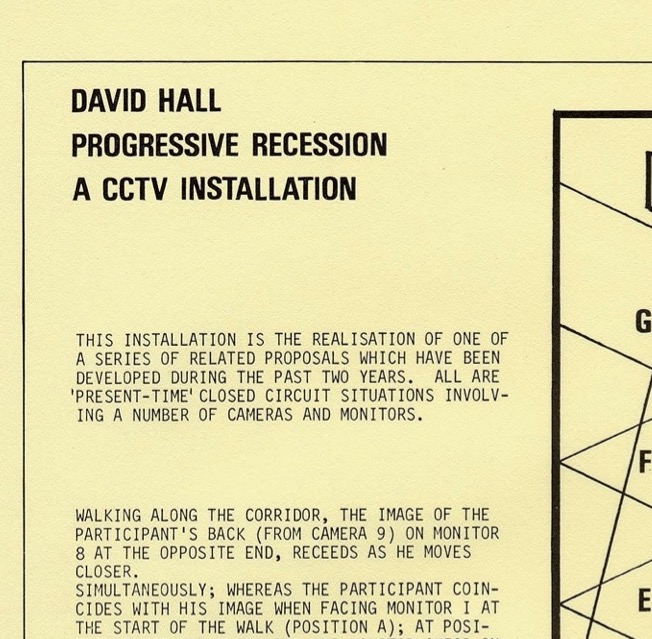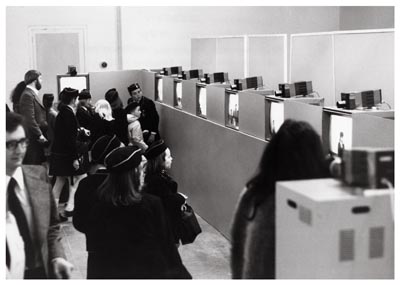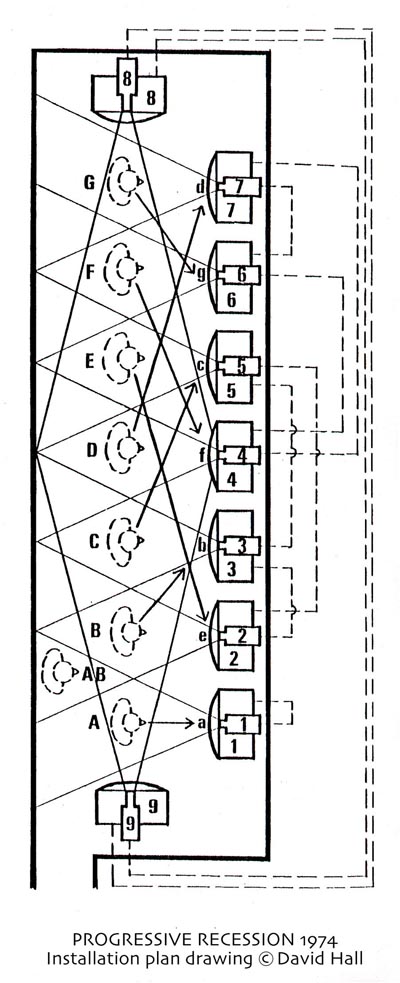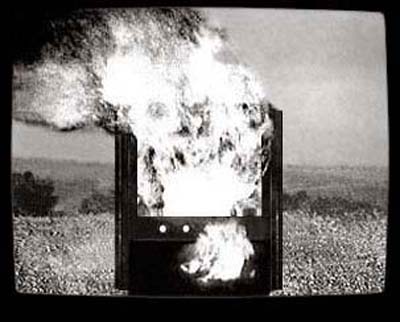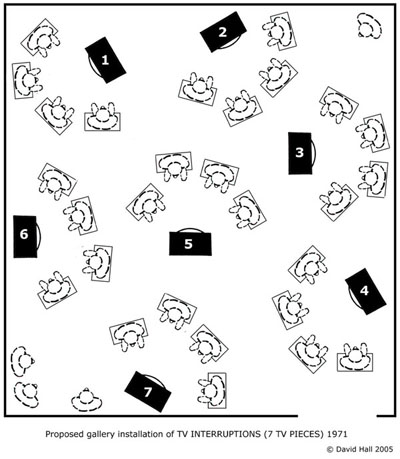1001 TV Sets (End Piece) 1972-2012

Creator:
Hall, David-
Media types:
Video
Type of work:Installation
Funding source: University of Westminster
First exhibited: Ambika P3, London, 16 March 2012- 22 April 2012
Ambika P3 (curated by Michael Maziere), presented a major solo exhibition by David Hall, the influential pioneer of video art, featuring a new commission 1001 TV Sets (End Piece)’ 1972-2012, as well as re staging two seminal early works. This timely exhibition vividly heralded the end of analogue TV in the UK as London finally switched to digital in April 2012.
Exhibited Works: 1001 TV Sets (End Piece) 1972-2012; Progressive Recession 1974; TV Interruptions (7 TV Pieces): The Installation 1971/2006
Ambika P3 is delighted to present a major solo exhibition by David Hall, the influential pioneer of video art, featuring a monumental new commission 1001 TV Sets (End Piece)’ 1972-2012, as well as restaging two seminal early works.
This timely exhibition vividly heralds the end of analogue TV in the UK as London finally switches to digital on 18 April 2012.
The contemporary reworking of one of Hall’s early major works ‘101 TV sets’ will form the centrepiece of the exhibition. 1001 TV Sets (End Piece)‘ features 1,001 cathode ray tube TV sets, of all ages and conditions, which will fill the massive Ambika P3 subterranean space. The TVs will be tuned to different analogue stations playing randomly in a cacophony of electronic signals, gradually reducing between April 4 and April 18, as the final analogue signals are broadcast from London’s Crystal Palace. When transmission is turned off, the multiple sets will emit only terminal audio hiss and a visual sea of white noise.
David Hall’s first works for television appeared unannounced on Scottish TV in 1971. The transmissions were a surprise, a mystery, and have been acknowledged as the first artist interventions seen on British television. An installation version of these early TV Interruptions will be exhibited in Ambika P3 alongside Progressive Recession a multi-screen interactive work utilising 9 cameras and 9 monitors as complex analogical mirrors.
Internationally recognised for his groundbreaking work in the field of video art, David Hall (b. 1937) has often been cited as its most influential pioneer in Britain. Hall started his work as a sculptor and was awarded first prize for sculpture at the Biennale de Paris in 1965 and the following year he took part in the first major exhibition of Minimalist art, Primary Structures, New York (1966) before turning to photography, film and video. He participated in the formation of the Artist Placement Group with John Latham and others in 1966; was a co-organiser of the seminal international Video Show exhibition at the Serpentine Gallery, London in 1975; and was co-curator of the first video installations exhibition at Tate in 1976. In the same year he initiated and was a founding member of the artists’ organisation London Video Arts (now part of LUX). His work is in major international collections and has recently featured in exhibitions in Vienna, Berlin, Toronto, Dresden and Santiago de Compostela.
Ambika P3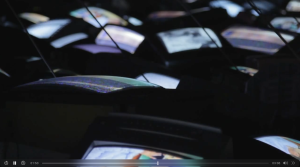
Close up of the installation -
-
Quotes:
This is the end -David Hall, 1001 TV Sets (End Piece), 1972-2012 at Ambika P3
Yesterday I turned on my television set. Not in order to ‘watch TV’. No, the objective of this intrusion on my visual field was to witness the death of television as I had known it now that the analogue signal is to be turned off. It happened instantaneously without pomp or circumstance. A kind of death, like that suffered by the rude and forgettable forefathers in a Thomas Gray poem, neither celebrated nor documented, but verified on a screen by merely an absence. One of many lost photogenic lovers laid to rest and soon to be forgotten. Now gone, what remains is a stream of interrupting aimless horizontals fluctuating and flickering meaninglessly, no longer identifiable, a cacophonous white noise quite difficult to bear.
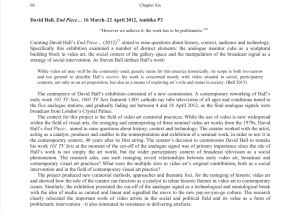
Michael Maziere essay in The Post-Industrial Landscape Chapter 6 David Hall, the influential pioneer British video artist must have anticipated this, must have wondered about the meaning of ‘the end’. The end of something which was, for him, so central, so vital to his work as an artist. 1001 TV Sets (End Piece) 1972-2012 at Ambika P3 captures this moment; its scale, colossal, in what Hall describes as an ‘event’. This event features 1001 cathode ray tube TV sets, of varied ages and models, tuned to different stations receiving television signals which will gradually be switched off over the course of a few days until on 18th April, the final analogue signals are broadcast from London’s Crystal Palace. Once the final signal is shut down, the televisions will cease their function of reception and transmission.
To enter Ambika P3, one walks into the gallery as if overseeing the spectacle from the dress circle. Below, in the vast pit of the subterranean gallery space, the analogue television signal has now ceased transmission, leaving witness to a field of the endless television barrage that is 1001 TV sets varyingly set on flatbed scaffolding, each set turned upward to face the heavens as their source of life has now been switched off. Descending the stairway, comatosed by the din that is the anti-sound of static produced by bodies with nothing to receive, I am confronted by carcass upon carcass of television set after television set, flat on their backs. I feel as though I am witness to a desert of beached whales, or myself part of some grand funeral procession. We march with slow and cautious footfall as if honouring the dead with last the rights before they are forever laid to rest, a final glance upon what was the face of a trusted loved on.Their carcasses now vestiges of an almost entirely extinct thinking, a world view on the edge of a deeper and more profound extinction. I am not unaware that I am witness to the imminent oblivion of all ideas, thoughts, conceptions, ideologies and creations connected with the reading within an analogue framework. A way of thinking, a set of problems, an entire universe of Platonic forms, already being laid to rest and marked by this one insignificant event. In a digital age, Zeno’s paradox becomes irrelevant, meaningless even. The notion of infinite divisibility no longer a problem, but instead an asset, if not edict. Continuity and contiguity, so much part of our ‘human’ understanding of time, perhaps indeed our humanity, lose their relevance. Time becomes, like packets of information, infinitely re-arrangeable, pieces of a puzzle to be managed and manipulated, re-formulated and re-created. ‘Moments’ themselves become found objects over which the imagination can lay creative claim and any notion of history, itself becomes history.
Despite these thoughts, the work is strangely exhilarating. There is something uplifting, perhaps even empowering, in partaking in Hall’s witnessing of this event. It is almost as if to say, in defiance of everything – ‘I have lived’. Television becomes a metaphor for memory, its fleetingly indeterminate character, while the box, like a body whose usefulness has now past becomes resigned to the rubbish heap. Eventually all things are, like memory, ephemeral. And that perhaps, more than any other, is the reason to make art, to assert meaning.
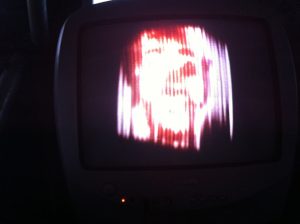
David Hall, 1001 TV Sets (End Piece) 1972-2012 at Ambika P3, Stooky Bill
Photo: R.KeshvaniEven after the signals have been turned off, one television continues to capture a signal. The bizarre and surreal head of Stooky Bill, plays on one of the screens. Stooky Bill was a wooden ventriloquist’s dummy used by Scottish engineer and entrepreneur, John Logie Baird to effect the first television transmission in 1925. Stooky Bill’s image becomes an eerie manifestation amidst the continuous din. It was, somewhat ironically, the first television interruption, even before David Hall’s now notorious works. David Hall’s own television interruption videos appeared almost subversively on Scottish TV in 1971 in the final hours of broadcasting without viewers being made aware that they were reflexive interventions.
On one level, television, beginning with Stooky Bill, is in effect an interruption emanating from an artificial imagined world to that of the ‘real’ world, an interruption that itself feeds into the real and eventually becomes so much a part of the ‘real’, that Hall would create an opposition — His video piece interruptions functioning as counterfactuals to, and interventions into, the ‘real’ of television. David Hall’s TV Interruptions (7 TV Pieces), vestiges of the now dead beast, take on a new meaning and are displayed, as if in eulogy, in the final space of the gallery.
by Rozemin Keshvani




